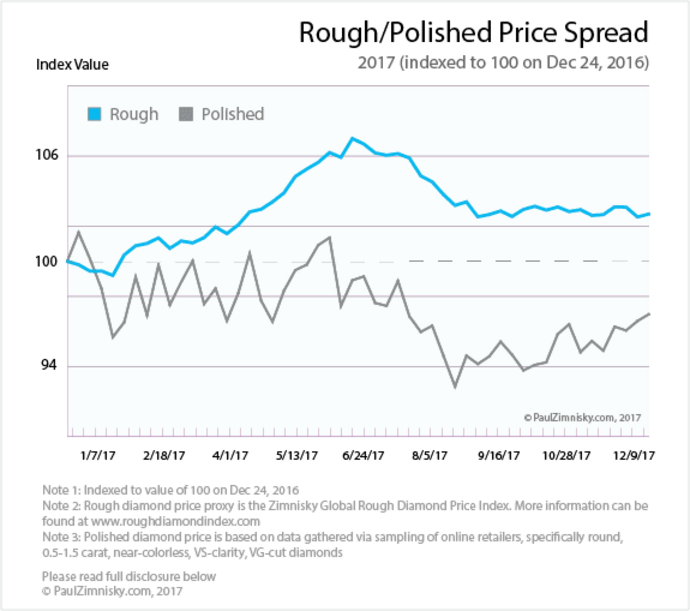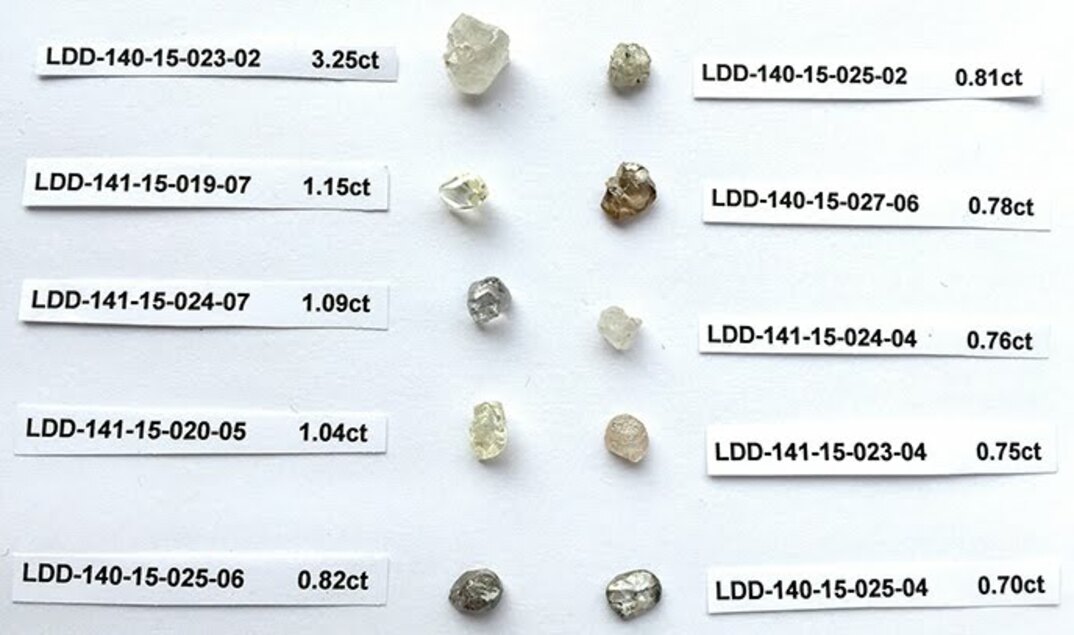
Chart of rough and polished diamond price spread in 2017
The majority of industry participants would agree the first half of 2017 was strong, with second half relatively disappointing. Demand for rough diamonds returned aggressively in early-2017 as manufacturers in India recovered from the late-2016 liquidity crisis caused by the government's demonetisation policy.
- Indian billionaire Anil Agarwal, who has a fond interest in diamonds and is now the largest shareholder of De Beers' parent Anglo American after accumulating shares throughout 2017, could make a move to gain control of the company in 2018;
- Next year, Alrosa will decide whether to rebuild or close the Mir mine after a flooding accident in August; a decision to permanently close the mine would be supportive of global supply/demand dynamics, eg the loss of Mir production would offset the combined new supply from Renard and Liqhobong (two of the three mines that commenced production this year);
- In December, Tiffany & Co stock rallied to just shy of an all-time high in part due to takeover speculation, an event that could possibly play out in 2018 as favour for international luxury returns;
- Lucara Diamond Corp is back to mining fresh South Lobe ore, the portion of the Karowe orebody that produced the Lesedi La Rona and Constellation diamonds. With a new advanced large-stone recovery system in place, Lucara has the potential to produce more newsworthy diamonds in 2018;
- Signet Jewelers could recover after a disappointing 2017 as company-wide restructuring plays out, including selling its customer credit portfolio, closing underperforming mall-based stores, expanding at off-mall locations, integrating web and digital into sales strategies, and executive level change;
- Zimbabwe's government-run ZMDC (private) has commenced conglomerate mining at the Maragne fields with $30 million of new equipment. This could increase production in 2018 to an estimated 3.5Mct from just over 2Mct in 2017;
- De Beers' Voorspoed mine in South Africa, Gem Diamond's Ghaghoo mine in Botswana, and previous-Rio Tinto diamond project Bunder, are all up for sale and could have new owners in 2018;
- As production at De Beers' and Mountain Province Diamonds' Gahcho Kué mine approaches deeper depths in 2018, more production could come from center-lobe ore. This is expected to be of lower grade but host higher-quality diamonds;
- Kennady Diamonds and Peregrine Diamonds both disclosed they had been in discussions with potential strategic partners in 2017, an indication of possible M&A deals in 2018;
- Stornoway Diamonds' waste sorting circuit, being installed to alleviate diamond breakage during processing, could prove effective when it goes live in the June quarter, the likely result being a higher average diamond price achieved for Stornoway's Renard goods;
- Following a disappointing 2017, mining of lower-grade areas at Firestone Diamonds' Liqhobong mine nears completion and production is expected to move to areas of the open pit that host higher-quality diamonds in 2018;
- A review of the proposed South African mining charter will take place in mid-February, which could have implications on ownership and operations of diamond companies in the country affecting the likes of De Beers and Petra Diamonds;
- Further work at Luaxe in 2018, arguably the most important undeveloped diamond project in the world, could provide further clarity on resource and production details and a production start date, which is now anticipated for some time after 2020;
- A continued weaker US dollar in 2018 could support momentum in global consumer luxury demand, while a shift in trajectory could have an adverse effect;
- An updated feasibility study on Shore Gold's Star-Orion South project in Saskatchewan, Canada, is anticipated in 2018. This could change the economics of the project by reducing an almost $2 billion pre-production capital expenditure total;
- North Arrow Minerals is expected to set up an exploration camp and drill its Mel property in 2018, the site of Canada's newest diamond discovery, further indicating the significance of the discovery;
- Lab-created diamond production is expected to continue to increase in 2018, however wider-consumer appetite for the product is still unclear and production of larger gem-quality stones is still just a fraction of the natural equivalent production;
- Dunnedin Ventures has plans to conduct the company's first drill programme in 2018 at its Kahuna project in Canada's Nunavut territory. This could result in a new discovery near the former-producing Jericho mine;
- Lucapa Diamond expects to commence production at Mothae in Lesotho in the second half of 2018, a mine with the potential to produce diamonds worth in excess of $1,000 per carat on average;
- The Diamond Producers Association, established by the diamond industry to return genetic marketing to diamonds, could impact consumer demand following the launch of a second US campaign, a first Indian campaign in November 2017, and a first Chinese campaign in April 2018;
- Five Star Diamonds plans to continue progressing exploration and development on over 20 kimberlite projects in 2018. This could lead to Brazil eventually becoming a more important contributor to global diamond supply;
- US-based lab-created diamond producer Diamond Foundry plans to build a "MegaCarat foundry" in Washington state, with first reactors to be deployed by the June quarter, adding to the company's current annual production estimate of approximately 100,000ct.
TOPICS:
- Diamonds
- Ghaghoo
- Bunder
- voorspoed
- Gahcho Kué
- Renard
- liqhobong
- Luaxe
- Star-Orion
- Kahuna
- Diamonds
- Anglo American
- De Beers
- Alrosa Co
- Lucara Diamond Corp
- Rio Tinto
- Petra Diamonds
- Mountain Province Diamonds
- Kennady Diamonds
- Peregrine Diamonds
- Stornoway Diamond Corp
- Firestone Diamonds
- Shore Gold
- Lucapa Diamond
- Five Star Diamonds


























